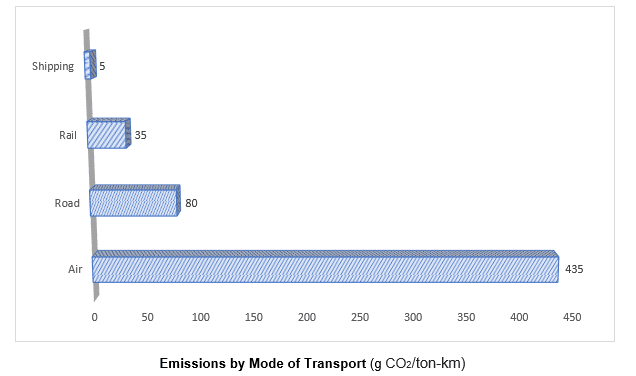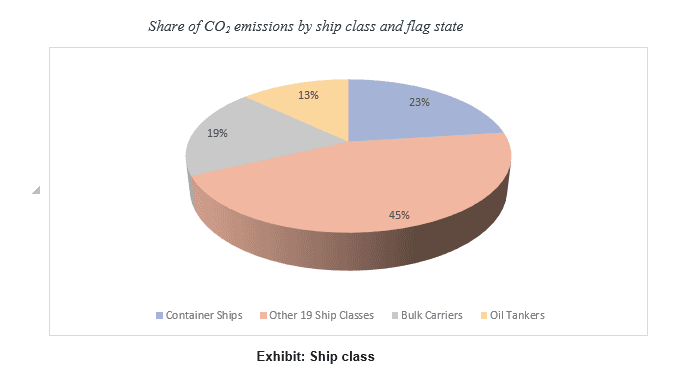Charting a Sustainable Course: Embracing Greener Shipping for a Cleaner Future
Environmentally friendly transportation is the transportation of people and goods with minimal use of resources and energy to protect the environment from pollutants produced by ships. Green Shipping promotes cleaner practices to implement emissions control, efficient port management and facility management.

Emissions by Mode of Transport (g CO2/ton-km)
These days, shipping accounts for about 3% of total carbon emissions. This figure is not as high as, for example, emissions of sulfur (15% of the total) and particulate matter (11% of the total), which are more serious problems. These emissions are due to fuel consumption, which accounts for more than 50% of the operating costs of transportation. Therefore, the type of fuel used for sea freight transportation is of paramount importance to the environment.
The guiding light
The International Maritime Organization (IMO) has played a major role in promoting environmentally friendly shipping. By 1 January 2020, it has ordered the sulfur content of fuel ships to be reduced from 3.5% at present to 0.5%. They also set an industry goal to reduce greenhouse gas (GHG) emissions by at least 50%. By 2050 compared to 2008 levels, it will reduce the average carbon intensity of the sector by at least 40% by 2030 and 70% by 2050.
Vessels are also required to manage ballast water in accordance with D-1 and D-2 standards. This standard requires that at least 95% of the ballast water by volume be exchanged and discharged away from shore to limit the introduction of certain harmful microorganisms into the sea for human health and marine ecosystems.
Benefits of greener shipping
The International Maritime Organization is taking steps to reduce ship emissions by reducing the sulfur content of ship fuel oil. In response, the shipping industry has started looking at several solutions including low sulfur fuel oil (LSFO), marine gas oil (MGO), liquefied natural gas (LNG) and even burning current fuels also began to consider using a scrubber in the stack.
Use of Green Hydrogen
Green hydrogen, an alternative fuel produced using clean energy, has been identified as a clean energy source that will lead the world to net zero emissions.
Green hydrogen is a fuel made from renewable energy. The hydrogen produced is said to be green if the electricity is produced by renewable energies such as solar or wind power. This has the potential to provide zero-emission power for ships.
Reduce empty containers
Reducing the movement of empty containers reduces fuel consumption, congestion and emissions.
Cleaner trends in maritime and Greener Ships
- Some representatives of the shipping industry plan to train ships with special exhaust gas cleaners (previously scrubbers that allow the use of high-sulphur fuels), but the content of harmful substances in the exhaust gases should also comply with the standards. By the end of 2020, around 3,000 ships worldwide are expected to be equipped with scrubbers, and around 1,000 more scrubbers are expected to be launched by early 2021. In total, the world’s merchant fleet comprises more than 94,000 of ships, among which includes 51,000 units, displacing more than 1,000 tons.
- The second part and this is the majority of shipowners, goes to the application of new special fuel, very low sulfur fuel oil, or VLSFO (very low sulfur fuel oil). Sulfur content is 0.5% or 7 times lower than in sulfur fuel oil (high sulfur fuel oil, HSFO), which is more IMO compliant.
Recent Developements
At the World Radiocommunication Conference 2023 (WRC-23), to be held in Dubai, United Arab Emirates from 20 November to 15 December 2023, ITU Member States will introduce new maritime communication systems to contribute to this to decide on Optimize ship traffic and reduce ship fuel consumption.
Share of CO2 emissions by ship class and flag state


Conclusion
The journey to net zero is a long and arduous journey. It takes the right skills and the right environment for industry, business, government and academia to work together so that the best ideas can be shared, and the best minds can be brought together. Additionally, we need to look outside the industry and take some important lessons from other industries.
Author: Bobby Singh
